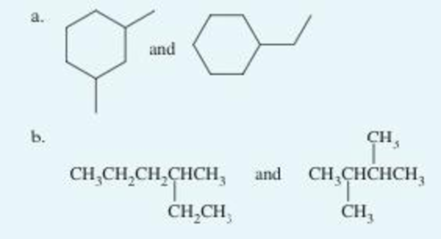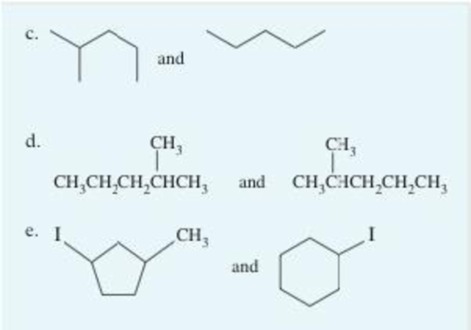
GENERAL ORGANIC+BIO...(LL)-W/MOD.ACCESS
3rd Edition
ISBN: 9780134466699
Author: FROST
Publisher: PEARSON
expand_more
expand_more
format_list_bulleted
Concept explainers
Textbook Question
Chapter 4, Problem 4.31PP
Determine the relationship between each of the pairs of the following compounds. Are they structural isomers (different molecules), conformational isomers (the same molecule), or not related?


Expert Solution & Answer
Want to see the full answer?
Check out a sample textbook solution
Students have asked these similar questions
Show work
Is this aromatic, antiaromatic, or nonaromatic?
On what basis are Na and Nb ranked against each other?
Chapter 4 Solutions
GENERAL ORGANIC+BIO...(LL)-W/MOD.ACCESS
Ch. 4 - Prob. 4.1PPCh. 4 - Prob. 4.2PPCh. 4 - Prob. 4.3PPCh. 4 - Draw a skeletal structure for ethane, C2H6. Do you...Ch. 4 - Prob. 4.5PPCh. 4 - Prob. 4.6PPCh. 4 - Draw a Lewis structure for each of the following...Ch. 4 - Draw a Lewis structure for each of the following...Ch. 4 - Prob. 4.9PPCh. 4 - Prob. 4.10PP
Ch. 4 - Prob. 4.11PPCh. 4 - Prob. 4.12PPCh. 4 - Write the condensed structure for the...Ch. 4 - Write the condensed structure for the...Ch. 4 - Write the skeletal structure for the alkane shown:...Ch. 4 - Write the skeletal structure for the alkane shown:...Ch. 4 - Identify the family of hydrocarbon present in the...Ch. 4 - Identify the family of hydrocarbon present in the...Ch. 4 - Identify all the functional groups present in the...Ch. 4 - Prob. 4.20PPCh. 4 - The most prevalent fatty acid in coconut oil is...Ch. 4 - The most common fatty acid found in animals is...Ch. 4 - Draw the condensed structural formula for each of...Ch. 4 - Give the correct name for each of the following...Ch. 4 - Draw the skeletal structure for each of the...Ch. 4 - Prob. 4.26PPCh. 4 - Prob. 4.27PPCh. 4 - Prob. 4.28PPCh. 4 - Prob. 4.29PPCh. 4 - Prob. 4.30PPCh. 4 - Determine the relationship between each of the...Ch. 4 - Determine the relationship between each of the...Ch. 4 - Determine if each of the following cycloalkanes or...Ch. 4 - Determine it each of the following cycloalkanes or...Ch. 4 - Mark the chiral centers in the following...Ch. 4 - Mark the chiral centers in the following...Ch. 4 - Convert each of the Lewis structures shown into a...Ch. 4 - Convert each of the Lewis structures in Problem...Ch. 4 - Prob. 4.39APCh. 4 - Prob. 4.40APCh. 4 - Convert the skeletal structures shown to condensed...Ch. 4 - Convert the skeletal structures shown to condensed...Ch. 4 - Prob. 4.43APCh. 4 - Prob. 4.44APCh. 4 - Alkanes are also referred to as saturated...Ch. 4 - Are alkanes considered polar or nonpolar...Ch. 4 - Give the skeletal structure and name of the...Ch. 4 - Give the skeletal structure and name of the...Ch. 4 - Name the following straight-chain alkanes or...Ch. 4 - Name the following straight-chain alkanes or...Ch. 4 - Explain the structural difference between a...Ch. 4 - Prob. 4.52APCh. 4 - Identify all of the functional groups in each of...Ch. 4 - Identify all of the functional groups in each of...Ch. 4 - Prob. 4.55APCh. 4 - Prob. 4.56APCh. 4 - Prob. 4.57APCh. 4 - Draw skeletal structures for each of the following...Ch. 4 - Prob. 4.59APCh. 4 - Prob. 4.60APCh. 4 - Prob. 4.61APCh. 4 - Prob. 4.62APCh. 4 - Prob. 4.63APCh. 4 - Prob. 4.64APCh. 4 - Prob. 4.65APCh. 4 - Prob. 4.66APCh. 4 - How many structural isomers are possible for the...Ch. 4 - Prob. 4.68APCh. 4 - Prob. 4.69APCh. 4 - Prob. 4.70APCh. 4 - For each of the following compounds, indicate...Ch. 4 - Prob. 4.72APCh. 4 - Determine whether each of the following is the cis...Ch. 4 - Determine whether each of the following is the cis...Ch. 4 - Prob. 4.75APCh. 4 - Prob. 4.76APCh. 4 - Mark the chiral centers in the following...Ch. 4 - Mark the chiral centers in the following...Ch. 4 - Prob. 4.79APCh. 4 - Prob. 4.80APCh. 4 - Prob. 4.81CPCh. 4 - Prob. 4.82CPCh. 4 - Prob. 1IA.1QCh. 4 - Prob. 1IA.2QCh. 4 - Prob. 1IA.3QCh. 4 - Prob. 1IA.4QCh. 4 - Prob. 1IA.5QCh. 4 - Prob. 1IA.6QCh. 4 - Prob. 1IA.7QCh. 4 - Prob. 1IA.8QCh. 4 - Prob. 1IA.9QCh. 4 - Prob. 1IA.10QCh. 4 - Prob. 1IA.11QCh. 4 - Prob. 2IA.1QCh. 4 - Prob. 2IA.2QCh. 4 - Prob. 2IA.3QCh. 4 - Prob. 2IA.4QCh. 4 - Prob. 2IA.5QCh. 4 - What is the molecular shape (geometry) of the...Ch. 4 - Prob. 2IA.7QCh. 4 - Prob. 1ICCh. 4 - Prob. 2ICCh. 4 - Prob. 3ICCh. 4 - Prob. 4IC
Knowledge Booster
Learn more about
Need a deep-dive on the concept behind this application? Look no further. Learn more about this topic, chemistry and related others by exploring similar questions and additional content below.Similar questions
- Step 1: add a curved arrow. Select Draw Templates More / " C H Br 0 Br : :o: Erase H H H H Q2Q Step 2: Draw the intermediates and a curved arrow. Select Draw Templates More MacBook Air / " C H Br 0 9 Q Erase 2Qarrow_forwardO Macmillan Learning Question 23 of 26 > Stacked Step 7: Check your work. Does your synthesis strategy give a substitution reaction with the expected regiochemistry and stereochemistry? Draw the expected product of the forward reaction. - - CN DMF MacBook Air Clearly show stereochemistry. Questionarrow_forwardNH2 1. CH3–MgCl 2. H3O+ ? As the lead product manager at OrganometALEKS Industries, you are trying to decide if the following reaction will make a molecule with a new C - C bond as its major product: If this reaction will work, draw the major organic product or products you would expect in the drawing area below. If there's more than one major product, you can draw them in any arrangement you like. Be sure you use wedge and dash bonds if necessary, for example to distinguish between major products with different stereochemistry. If the major products of this reaction won't have a new C - C bond, just check the box under the drawing area and leave it blank. Click and drag to start drawing a structure. This reaction will not make a product with a new C - C bond. Х ☐: Carrow_forward
- Predict the major products of this organic reaction. If there will be no major products, check the box under the drawing area instead. No reaction. : + Х è OH K Cr O 2 27 2 4' 2 Click and drag to start drawing a structure.arrow_forwardLaminar compounds are characterized by havinga) a high value of the internal surface of the solid.b) a high adsorption potential.arrow_forwardIntercalation compounds have their sheetsa) negatively charged.b) positively charged.arrow_forward
- Indicate whether the following two statements are correct or not:- Polythiazine, formed by N and S, does not conduct electricity- Carbon can have a specific surface area of 3000 m2/garrow_forwardIndicate whether the following two statements are correct or not:- The S8 heterocycle is the origin of a family of compounds- Most of the elements that give rise to stable heterocycles belong to group d.arrow_forwardcould someone draw curly arrow mechanism for this question pleasearrow_forward
arrow_back_ios
SEE MORE QUESTIONS
arrow_forward_ios
Recommended textbooks for you
- Chemistry: Matter and ChangeChemistryISBN:9780078746376Author:Dinah Zike, Laurel Dingrando, Nicholas Hainen, Cheryl WistromPublisher:Glencoe/McGraw-Hill School Pub Co
 Organic And Biological ChemistryChemistryISBN:9781305081079Author:STOKER, H. Stephen (howard Stephen)Publisher:Cengage Learning,
Organic And Biological ChemistryChemistryISBN:9781305081079Author:STOKER, H. Stephen (howard Stephen)Publisher:Cengage Learning, General, Organic, and Biological ChemistryChemistryISBN:9781285853918Author:H. Stephen StokerPublisher:Cengage Learning
General, Organic, and Biological ChemistryChemistryISBN:9781285853918Author:H. Stephen StokerPublisher:Cengage Learning  Chemistry for Today: General, Organic, and Bioche...ChemistryISBN:9781305960060Author:Spencer L. Seager, Michael R. Slabaugh, Maren S. HansenPublisher:Cengage Learning
Chemistry for Today: General, Organic, and Bioche...ChemistryISBN:9781305960060Author:Spencer L. Seager, Michael R. Slabaugh, Maren S. HansenPublisher:Cengage Learning Introductory Chemistry: An Active Learning Approa...ChemistryISBN:9781305079250Author:Mark S. Cracolice, Ed PetersPublisher:Cengage Learning
Introductory Chemistry: An Active Learning Approa...ChemistryISBN:9781305079250Author:Mark S. Cracolice, Ed PetersPublisher:Cengage Learning

Chemistry: Matter and Change
Chemistry
ISBN:9780078746376
Author:Dinah Zike, Laurel Dingrando, Nicholas Hainen, Cheryl Wistrom
Publisher:Glencoe/McGraw-Hill School Pub Co

Organic And Biological Chemistry
Chemistry
ISBN:9781305081079
Author:STOKER, H. Stephen (howard Stephen)
Publisher:Cengage Learning,

General, Organic, and Biological Chemistry
Chemistry
ISBN:9781285853918
Author:H. Stephen Stoker
Publisher:Cengage Learning


Chemistry for Today: General, Organic, and Bioche...
Chemistry
ISBN:9781305960060
Author:Spencer L. Seager, Michael R. Slabaugh, Maren S. Hansen
Publisher:Cengage Learning

Introductory Chemistry: An Active Learning Approa...
Chemistry
ISBN:9781305079250
Author:Mark S. Cracolice, Ed Peters
Publisher:Cengage Learning
Chapter 4 Alkanes and Cycloalkanes Lesson 2; Author: Linda Hanson;https://www.youtube.com/watch?v=AL_CM_Btef4;License: Standard YouTube License, CC-BY
Chapter 4 Alkanes and Cycloalkanes Lesson 1; Author: Linda Hanson;https://www.youtube.com/watch?v=PPIa6EHJMJw;License: Standard Youtube License